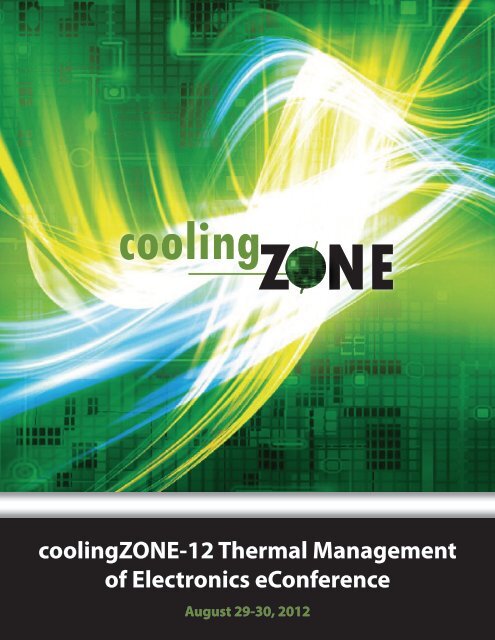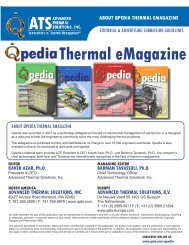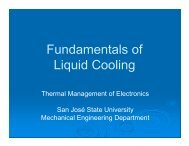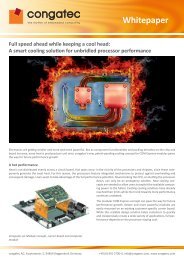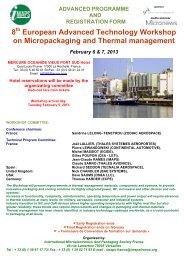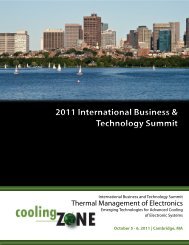coolingZONE-12 Thermal Management of Electronics eConference
coolingZONE-12 Thermal Management of Electronics eConference
coolingZONE-12 Thermal Management of Electronics eConference
Create successful ePaper yourself
Turn your PDF publications into a flip-book with our unique Google optimized e-Paper software.
cooling<br />
Z NE<br />
<strong>coolingZONE</strong>-<strong>12</strong> <strong>Thermal</strong> <strong>Management</strong><br />
<strong>of</strong> <strong>Electronics</strong> <strong>eConference</strong><br />
August 29-30, 20<strong>12</strong>
<strong>coolingZONE</strong>-<strong>12</strong> <strong>Thermal</strong> <strong>Management</strong> <strong>of</strong> <strong>Electronics</strong> <strong>eConference</strong> is a in innovative approach to thermal<br />
management and heat transfer conferences. This event will stream world renown experts in thermal<br />
management discussing emerging technologies for advanced cooling <strong>of</strong> electronic systems. Engineers<br />
across the globe will be attending, from the convenience <strong>of</strong> their <strong>of</strong>fices and labs, to learn what new cooling<br />
challenges will confront them, where the solutions will be found, and who can help them with effective<br />
products and services to manage today’s thermal challenges. Attendees can register for the full two-day<br />
conference or by individual day.<br />
How Does an <strong>eConference</strong> Work?<br />
<strong>Thermal</strong> <strong>Management</strong> <strong>of</strong><br />
<strong>Electronics</strong> <strong>eConference</strong><br />
August 29-30, 20<strong>12</strong><br />
After registering for <strong>coolingZONE</strong>-<strong>12</strong> attendees will receive a confirmation email followed by an email with<br />
instructions on logging into the <strong>eConference</strong>. The entire conference will be recorded and attendees will be<br />
able to view the presentation archives. A high speed internet connection is required. For more information<br />
view the “<strong>coolingZONE</strong>-<strong>12</strong> <strong>Thermal</strong> <strong>Management</strong> <strong>of</strong> <strong>Electronics</strong> <strong>eConference</strong> System Requirements.”<br />
Who Should Attend?<br />
Engineers, engineering managers and executives, chief technical <strong>of</strong>ficers, project managers, pr<strong>of</strong>essors,<br />
students and others who want insight into the thermal design issues that affect product performance and the<br />
latest advancements in solving these critical thermal challenges<br />
Pricing<br />
One Day <strong>eConference</strong>:<br />
Wednesday August 29, 20<strong>12</strong> OR Thursday August 30, 20<strong>12</strong> $295 per person<br />
Full Two-Day <strong>eConference</strong>:<br />
Wednesday August 29, 20<strong>12</strong> AND Thursday August 30, 20<strong>12</strong> $495 per person<br />
Register online at www.coolingzone.com<br />
through our secure online processing
System Requirements<br />
Please check to see that you meet the minimum system requirements prior to joining the conference. What<br />
are the system requirements for running? For further help or clarification beyond these instructions, please<br />
contact our <strong>eConference</strong> platform partner, GoToMeeting.<br />
Windows<br />
<strong>Thermal</strong> <strong>Management</strong> <strong>of</strong><br />
<strong>Electronics</strong> <strong>eConference</strong><br />
August 29-30, 20<strong>12</strong><br />
Operating System Windows 2003 Server<br />
Windows XP<br />
Windows Vista<br />
Windows 7<br />
Processor 2.4GHz or more<br />
RAM 2BG or more<br />
Internet DSL or better<br />
Bandwith 700Kbps or more for simultaneous screen sharing, video, and audio conferencing<br />
Browser Internet Explorer® 7.0 or newer<br />
Mozilla Firefox® 4.0 or newer<br />
Google Chrome TM 5.0 or newer<br />
Additional S<strong>of</strong>tware JavaScript TM 1.6 or higher<br />
Mac<br />
Operating System Mac OS® X 10.5 (Leopard®)<br />
Mac OS® X 10.6 (Snow Leopard®)<br />
Mac OS® X 10.7 (Lion®)<br />
Mac OS® X 10.8 (Mountain Lion®)<br />
Processor 2.4GHz Intel Processor (Core 2 Duo)<br />
RAM 1BG or more<br />
Internet DSL or better<br />
Bandwith 700Kbps or more for simultaneous screen sharing, video, and audio conferencing<br />
Browser Safari TM 3.0 or newer<br />
Mozilla Firefox® 4.0 or newer<br />
Google Chrome TM 5.0 or newer<br />
Additional S<strong>of</strong>tware JavaScript TM<br />
Visit www.coolingzone.com or www.gotomeeting.com for further technical information.
Welcome<br />
Keynote Address<br />
Intrachip Micr<strong>of</strong>luidic Cooling -<br />
Gen3 <strong>Thermal</strong> Packaging Technology<br />
Avram Bar-Cohen, Ph.D.<br />
Program Manager, DARPA-Microsystems Technology Office<br />
From the dawn <strong>of</strong> the Information Age thermal management technology has played a key<br />
role in the continuing miniaturization, performance improvements, and higher reliability <strong>of</strong><br />
electronic systems. During the past 65 years, thermal packaging has migrated from ventilation<br />
and air-conditioning to cabinet cooling, to package cooling with heat sinks and cold plates, and<br />
is today addressing on-chip hot spots and near-junction thermal transport. Following a brief<br />
history <strong>of</strong> thermal packaging, attention will turn to a review <strong>of</strong> emerging DARPA-driven micro-<br />
and nano-technologies for reducing the thermal resistance <strong>of</strong> defense electronic systems. The<br />
asymptotic maturation <strong>of</strong> current technology and growing thermal management demands in high<br />
performance computing and RF systems have led DARPA to initiate efforts in third-generation<br />
thermal management technology based on intrachip and interchip micr<strong>of</strong>luidic cooling. The<br />
motivation, technological thrusts, and promise <strong>of</strong> this new thermal management paradigm will<br />
be discussed.<br />
Technical Presentation<br />
<strong>Thermal</strong> <strong>Management</strong> <strong>of</strong><br />
<strong>Electronics</strong> <strong>eConference</strong><br />
August 29-30, 20<strong>12</strong><br />
Summit Program<br />
Wednesday, August 29, 20<strong>12</strong>
Materials for Microelectronic and LED Heat Dissipation<br />
Deborah D.L. Chung, Ph.D.<br />
Director, Composite Materials Research Laboratory<br />
Niagara Mohawk Chair Pr<strong>of</strong>essor <strong>of</strong> Materials Research<br />
Pr<strong>of</strong>essor <strong>of</strong> Mechanical and Aerospace Engineering<br />
University at Buffalo, State University <strong>of</strong> New York<br />
Overheating is one <strong>of</strong> the biggest problems in the microelectronic and LED industries, as it limits<br />
the power, reliability, performance and further miniaturization. This problem particularly affects<br />
high-performance and high-power devices. For heat dissipation from a hot surface, heat needs to<br />
flow from the hot surface to a heat sink or a heat spreader. A heat sink is a thermal conductor that<br />
has a considerable heat capacity so that it serves as a sink for the heat. A heat spreader is a thermal<br />
conductor that serves as a conduit to channel the heat away from the heat source. Heat is dissipated<br />
from both heat sink and heat spreader to the environment. Suitable thermal insulation to avoid the<br />
dissipated heat to degrade nearly electronic components is <strong>of</strong>ten needed. Due to the low thermal<br />
expansion coefficient <strong>of</strong> semiconductors and their substrates, a low thermal expansion coefficient<br />
is preferred for the heat sink/spreader; otherwise, thermal fatigue may occur upon temperature<br />
cycling. The effectiveness <strong>of</strong> the heat flow from the heat source to the heat sink/spreader is partly<br />
governed by the quality <strong>of</strong> the thermal contact between the heat source surface and the surface <strong>of</strong><br />
the heat sink/spreader. Improvement <strong>of</strong> the thermal contact requires a thermal interface material,<br />
which needs to be conformable. Conformability is essential due to the need to displace the air<br />
from the interface between contact surfaces that are necessarily not completely smooth. As long<br />
as the thermal conductivity exceeds that <strong>of</strong> air, a highly conformable thermal interface material is<br />
able to improve a thermal contact. A heat spreader can be isotropic or anisotropic; the latter has a<br />
low through-thickness thermal conductivity but a high in-plane thermal conductivity and has the<br />
advantage <strong>of</strong> providing some degree <strong>of</strong> thermal insulation so that the heat evolved does not affect<br />
the nearby electronic devices. The performance <strong>of</strong> isotropic and anisotropic heat spreaders depends<br />
on both the material and the dimensions, as shown by a heat conduction model.<br />
Technical Presentation<br />
State <strong>of</strong> the Art in <strong>Thermal</strong> <strong>Management</strong> –<br />
From Vacuum Tube to Super Computers<br />
Kaveh Azar, Ph.D.<br />
President and C.E.O, Advanced <strong>Thermal</strong> Solutions, Inc.<br />
<strong>Thermal</strong> management, more than ever before, has become the center <strong>of</strong> attention in a successful<br />
launch <strong>of</strong> a product. The challenge that we all face as product managers or engineers is to select,<br />
design or deploy a successful cooling solution suitable for the product at hand while meeting its<br />
market requirements. As the result, we <strong>of</strong>ten overlook what is available on the market and what<br />
has been developed to meet the cooling challenges <strong>of</strong> different electronics. The range <strong>of</strong> cooling<br />
options varies from natural convection in air to cryogenic cooling – or any other solution that lies<br />
in between. In this presentation, the cooling technologies that have been developed across the<br />
electronics market sector – ranging from consumer electronics to high capacity computing to<br />
military/avionics equipment, will be presented. The use and reason behind deployment <strong>of</strong> such<br />
cooling technologies along with their salient points will be discussed. The presentation will close<br />
with the options to exercise when selecting a cooling system while highlighting the best path for<br />
meeting the market requirements <strong>of</strong> a given electronic system.
Technical Presentation<br />
Indirect Liquid Cooling <strong>of</strong> <strong>Electronics</strong> with Micro- and Mini-Scale<br />
Cold Plates and Heat Sinks: Theoretical and Practical Implications<br />
for Enhanced Cooling and Energy Recovery<br />
Alfonso Ortega, Ph.D.<br />
James R. Birle Pr<strong>of</strong>essor <strong>of</strong> Energy Technology<br />
Associate Dean for Graduate Studies and Research<br />
Director, Laboratory for Advanced <strong>Thermal</strong> and Fluid Systems<br />
College <strong>of</strong> Engineering, Villanova University<br />
Indirect liquid cooling via cold plates and liquid cooled heat sinks has become a necessary part<br />
<strong>of</strong> the potential design space for cooling electronic systems as the thermal margin for air cooling<br />
vanishes. In high density Data Center applications, liquid cooling <strong>of</strong>fers the possibility not only <strong>of</strong><br />
enhanced cooling, but also increases the potential for waste energy recovery. As liquid cooled<br />
solutions start to seriously contend for implementation, understanding their behavior will lead<br />
to better design processes, tools, and ultimately optimized solutions. This lecture will focus on<br />
understanding the basic behavior <strong>of</strong> liquid cooled heat sinks and cold plates, in single and twophase<br />
flow. We will compare the various metrics that can be used to assess their performance,<br />
including the overall thermal resistance and the heat exchanger effectiveness. Finally, we will<br />
discuss the use <strong>of</strong> analysis tools in their design in particular to show the value <strong>of</strong> simple modeling<br />
approaches compared to full CFD approaches.<br />
Next Generation Embedded Liquid Cooling with Ultra Low<br />
<strong>Thermal</strong> Resistance<br />
Michael M. Ohadi, Ph.D.<br />
Pr<strong>of</strong>essor <strong>of</strong> Mechanical Engineering and Director <strong>of</strong> Advanced <strong>Thermal</strong> <strong>Management</strong> Laboratory<br />
CALCE <strong>Electronics</strong> Systems and Products Center<br />
Department <strong>of</strong> Mechanical Engineering, University <strong>of</strong> Maryland<br />
The demand for increased functionality <strong>of</strong> electronic products and the simultaneous trend<br />
<strong>of</strong> smaller feature size continue to raise dissipated power and the resulting power densities<br />
in electronic systems, introducing new challenges and opportunities in thermal management<br />
<strong>of</strong> modern electronics. Successful next generation thermal management systems will have to<br />
mitigate thermal limitations on the operation <strong>of</strong> high performance electronic systems to satisfy the<br />
increasing market demand for faster, smaller, lighter, and more energy efficient and cost effective<br />
products. The next generation cooling systems will integrate the thermal management techniques<br />
into the chip layout, and/or package design, to provide substantially enhanced cooling performance<br />
with ultra-low thermal resistance between chip-level heat generation and system-level heat<br />
removal path. This presentation will review most recent progress in embedded micro cooling<br />
systems, including use <strong>of</strong> use <strong>of</strong> thin film micro channel cooling. The technique involves utilization<br />
<strong>of</strong> 3-D structures and a distributed liquid delivery, with dedicated channels for vapor and liquid<br />
to maximize phase change heat transfer while facilitating isothermalization <strong>of</strong> the surface and<br />
minimizing the pressure drops and the associated pumping power requirements. Record-high heat<br />
transfer coefficients have been experimentally demonstrated with heat removal capability in excess<br />
<strong>of</strong> 1 kW/cm 2 and heat density <strong>of</strong> 1 kW/cm 3 .<br />
Technical Presentation
Welcome<br />
Keynote Address<br />
State <strong>of</strong> the <strong>Thermal</strong> <strong>Management</strong> Market<br />
Alan Wong, Ph.D.<br />
President and C.E.O, Aavid <strong>Thermal</strong>loy, LLC.<br />
Technical Presentation<br />
Summit Program<br />
Thursday, August 30, 20<strong>12</strong><br />
High-Performance <strong>Thermal</strong> <strong>Management</strong> Materials<br />
Carl Zweben, Ph.D.<br />
Advanced <strong>Thermal</strong> Materials Consultant<br />
Life Fellow, ASME; Fellow, SAMPE & ASM; Associate Fellow, AIAA<br />
<strong>Thermal</strong> <strong>Management</strong> <strong>of</strong><br />
<strong>Electronics</strong> <strong>eConference</strong><br />
August 29-30, 20<strong>12</strong><br />
In response to well-recognized needs, there have been revolutionary advances in thermal<br />
management materials. Silicon carbide particle-reinforced aluminum (Al/SiC), which was first used in<br />
thermal management by the speaker’s group at GE in the 1980s, is now well established. By replacing<br />
a copper base plate with Al/SiC, one IGBT supplier “eliminated solder fatigue”, extending guaranteed<br />
life from 10 to 30 years. There are an increasing number <strong>of</strong> new materials with low coefficients<br />
<strong>of</strong> thermal expansion (CTEs) and low densities having thermal conductivities up to 1700 W/m-K.<br />
Some are cheaper than traditional materials. Pay<strong>of</strong>fs include: increased reliability; reduced junction<br />
temperatures and weight; low-CTE, thermally conductive PCBs, potentially eliminating the need for<br />
underfill; CTE matching allows direct attach with hard solders, reducing thermal resistance and solder<br />
fatigue. There are a large and increasing number <strong>of</strong> microelectronic and optoelectronic applications,<br />
including: PCBs and PCB cold plates; heat sinks; microprocessor, RF and power modules; heat<br />
spreaders and sinks; LED and laser diode modules; thermoelectric coolers; plasma and LCD displays;<br />
detectors; and photovoltaics. This presentation covers the large and increasing number <strong>of</strong> advanced<br />
thermal management materials, including properties and the growing array <strong>of</strong> applications.
Technical Presentations<br />
Using Computers to Go Where Experiments Cannot:<br />
Massively-Parallel LES <strong>of</strong> Turbulent Heat Transfer<br />
Andrew T. Duggleby, Ph. D.<br />
Assistant Pr<strong>of</strong>essor, Department <strong>of</strong> Mechanical Engineering, Texas A&M University<br />
For decades, the steady increase in modern computing technology has allowed for faster as well<br />
as larger, more complex simulations. With all this computing power, there are still only two areas<br />
in which a numerical simulation is better than an experimental data: (1) quick, reliable (510-20%<br />
error) simulations for design optimization, and (2) massive resolution, highly accurate (< 1% error)<br />
simulations. In both cases the computer is going where experiments cannot. In quick simulation case,<br />
the simulations are faster and cheaper than any experiment, yielding results (hopefully trustworthy<br />
results) fast enough to be included in a design cycle. In the highly-resolved case, the resolution is<br />
far beyond any experimental measurements - in the context <strong>of</strong> turbulent heat transfer, the entire<br />
velocity, pressure, and temperature fields are known everywhere at all times. In this talk, the current<br />
state-<strong>of</strong>-the-art for both the quick simulations and the highly- resolved simulations will be discussed<br />
in the context <strong>of</strong> turbulent heat transfer. For the quick simulations, recent advances in not just<br />
simulation time, but total CAD to analysis time will be discussed: (a) Computer-Aided Design (CAD)<br />
model to mesh time, (b) simulation time, (c) accuracy vs time trade-os (models, resolution, etc), (d)<br />
analysis time. For computational fluid dynamics and heat transfer, this almost always refers to the<br />
steady-state Reynolds-Averaged Navier-Stokes (RANS) models, but an example will be given for a<br />
time-dependent Large Eddy Simulation <strong>of</strong> a venturi nozzle where CAD to analysis was done in under<br />
24 hours. For the highly-resolved simulations, analysis techniques to elucidate useful information out<br />
<strong>of</strong> terabytes <strong>of</strong> data are discussed, with an example <strong>of</strong> pin-n heat transfer direct numerical simulation<br />
(DNS) where the modes responsible for heat transfer are extracted via Proper Orthogonal Decomposition<br />
(POD), and then enhanced by endwall contouring resulting in increased convection with<br />
minimal drag increase.<br />
Next Generation Embedded Liquid Cooling with Ultra Low<br />
<strong>Thermal</strong> Resistance<br />
Mehdi Asheghi, Ph.D.<br />
School <strong>of</strong> Engineering, Stanford University,<br />
Panel Discussion<br />
Closing Remarks<br />
Presentation times subject to change in the event <strong>of</strong> unforseen events. In the event <strong>of</strong> change, updated schedules will be provided at registration.
About the Speakers<br />
<strong>Thermal</strong> <strong>Management</strong> <strong>of</strong><br />
<strong>Electronics</strong> <strong>eConference</strong><br />
August 29-30, 20<strong>12</strong><br />
Chris Aldham, Ph.D.<br />
Dr. Chris Aldham has worked in computational fluid dynamics (CFD) for over 30 years (starting with PHOENICS at CHAM<br />
with Pr<strong>of</strong>. Brian Spalding) and for more than 20 years in the field <strong>of</strong> electronics cooling. After 16 years at Flomerics, Chris<br />
joined Future Facilities as a Product Manager responsible for 6SigmaET – electronics cooling simulation s<strong>of</strong>tware which<br />
is part <strong>of</strong> a suite <strong>of</strong> integrated s<strong>of</strong>tware products that tackle head-on the challenges <strong>of</strong> data center lifecycle engineering<br />
(including equipment design analysis) through the Virtual Facility.<br />
Mehdi Asheghi, Ph.D. CO-CHAIR<br />
Dr. Mehdi Asheghi is currently a consulting associate pr<strong>of</strong>essor at the Stanford University focusing on further development<br />
<strong>of</strong> PCRAM technology. He completed his Ph.D. (1999) and postdoctoral (2000) at the Stanford university conducting<br />
research in the area <strong>of</strong> nanoscale thermal engineering <strong>of</strong> microelctronic devices. He is also with the iCONA Technology,<br />
which is a Palo Alto based research and development firm focusing on smart energy and thermal managements <strong>of</strong><br />
residential buildings. He led a well-known and funded research program (2000-2006) at the Carnegie Mellon University<br />
that focused on nanoscale thermal phenomena in semiconductor and data storage devices. He is the author <strong>of</strong> more than<br />
110 book chapters, journal publications and fully-reviewed conference papers.<br />
Kaveh Azar, Ph.D.<br />
Dr. Kaveh Azar is the President and CEO <strong>of</strong> Advanced <strong>Thermal</strong> Solutions, Inc. (ATS), a leading edge thermal management<br />
company involved in developing liquid and air cooling solutions for the telecomm and computing market sectors. Under<br />
Dr. Azar’s leadership, ATS has expanded globally with <strong>of</strong>fices in Europe and Asia, and has become the leading supplier<br />
<strong>of</strong> cooling solutions and thermal management consulting to the telecomm market sector. Prior to ATS, Dr. Azar was the<br />
founder and manager <strong>of</strong> Lucent Technologies thermal management center, responsible for developing the next generation<br />
<strong>of</strong> cooling systems. In addition, Dr. Azar has authored Lucent’s thermal roadmap and served as the corporate thermal<br />
consultant. While at Lucent, he developed a state-<strong>of</strong>-the- art thermal/fluids laboratory for simulation <strong>of</strong> components,<br />
boards and systems. Since 1985, Dr. Azar has been an active participant in electronics thermal community and has served<br />
as the organizer, general chair and the keynote speaker at the national and international conferences sponsored by ASME,<br />
IEEE and AIAA. He has also been an invitee to national bodies such as NSF, NIST and NEMI for organizing government<br />
and industry research goals in electronics cooling. Dr. Azar has been an adjunct pr<strong>of</strong>essor at a number <strong>of</strong> universities in the USA, and lecturers<br />
worldwide on different facets <strong>of</strong> electronics cooling. He holds more than 31 national and international patents, has published more than 73 articles,<br />
3 book chapters and a book entitled, “<strong>Thermal</strong> Measurements in <strong>Electronics</strong> Cooling” and has edited a 5 book series, “Qpedia – <strong>Electronics</strong> <strong>Thermal</strong><br />
<strong>Management</strong>.” In addition, he served as the Editor-in-Chief <strong>of</strong> <strong>Electronics</strong> Cooling Magazine for eleven years, and is currently the publisher <strong>of</strong><br />
Qpedia, a monthly publication dedicated to thermal management <strong>of</strong> electronic systems. Dr. Azar has received several recognitions within Bell Labs<br />
and other entities that include Bell Labs’ President Silver Award, Strathmore’s Who’s Who, The Uptime Institute for Visionary Leadership and IEEE<br />
SEMITHERM Significant Contributor Award in thermal management <strong>of</strong> electronics systems.<br />
Ruben Bons<br />
Ruben Bons is the <strong>Electronics</strong> Sector Manager with CD-adapco, responsible for understanding and addressing the market<br />
needs <strong>of</strong> electronics thermal management applications with STAR-CCM+. He joined CD-adapco about 1 year ago after<br />
previously working for Structural Research & Analysis Corporation and Blue Ridge Numerics. Ruben has spent more than<br />
15 years using, supporting, and selling a wide range <strong>of</strong> simulation programs including structural, thermal, flow, kinematic,<br />
and electromagnetic analyses. For the past 8 years most <strong>of</strong> his work has focused on the application <strong>of</strong> CFD to electronics<br />
thermal management. Ruben Bons is based in southern California in the United States.
<strong>Thermal</strong> <strong>Management</strong> <strong>of</strong><br />
<strong>Electronics</strong> <strong>eConference</strong><br />
August 29-30, 20<strong>12</strong><br />
Avram Bar-Cohen, Ph.D. KEYNOTE<br />
Dr. Avram Bar-Cohen is a Program Manager in the Microsystems Technology Office <strong>of</strong> the Defense Advanced Research<br />
Projects Agency (DARPA), Arlington, VA; he is serving in this capacity while on leave from his position as a Distinguished<br />
University Pr<strong>of</strong>essor at the University <strong>of</strong> Maryland, where he most recently also served as the Chair <strong>of</strong> the Mechanical<br />
Engineering Department (2001-2010). Bar-Cohen earned a PhD in mechanical Engineering from the Massachusetts<br />
Institute <strong>of</strong> Technology and prior to joining Maryland, Bar-Cohen directed the University <strong>of</strong> Minnesota’s Center for<br />
the Development <strong>of</strong> Technological Leadership and held the Sweatt Chair in Technological Leadership. His publications,<br />
lectures, short courses, and research, as well as pr<strong>of</strong>essional service in ASME and IEEE, have helped to create the scientific<br />
foundation for the thermal management <strong>of</strong> electronic components and systems and pioneered techniques for energyefficient<br />
sustainable design <strong>of</strong> manufactured products. Dr. Bar-Cohen has received numerous awards, including the<br />
prestigious International Centre for Heat and Mass Transfer’s 2008 Luikov Medal, ASME’s Heat Transfer Memorial Award<br />
(1999), and the IEEE CPMT Society’s Outstanding Sustained Technical Contributions Award (2002). He is among a very select number <strong>of</strong> ASME<br />
Honorary Members and is a Fellow <strong>of</strong> IEEE.<br />
Deborah Chung, Ph.D.<br />
Dr. Chung is National Grid Endowed Chair Pr<strong>of</strong>essor (since 1991), Director <strong>of</strong> the Composite Materials Research Laboratory<br />
(since 1989) and Pr<strong>of</strong>essor <strong>of</strong> Mechanical and Aerospace Engineering (since 1986) in SUNY/Buffalo. She was Associate<br />
Pr<strong>of</strong>essor <strong>of</strong> Metallurgical Engineering and Materials Science (1982-86) and Assistant Pr<strong>of</strong>essor (1977-82) in Carnegie<br />
Mellon University. She holds a Ph.D. degree (1977) in Materials Science and an S.M. degree (1975) from M.I.T., and an<br />
M.S. degree in Engineering Science (1973) and a B.S. degree in Engineering and Applied Science (1973) from California<br />
Institute <strong>of</strong> Technology. Awards received include the Charles E. Pettinos Award from the American Carbon Society (2004),<br />
Chancellor’s Award for Excellence in Scholarship and Creative Activities from SUNY (2003), Outstanding Inventor Award<br />
from SUNY (2002), Fellow conferral from American Carbon Society (2001) and ASM International (1998), “Teacher <strong>of</strong><br />
the Year” Award from Tau Beta Pi (1993), Teetor Educational Award from the Society <strong>of</strong> Automotive Engineers (1987),<br />
Hardy Gold Medal from American Institute <strong>of</strong> Mining, Metallurgical, and Petroleum Engineers (1980), and Ladd Award<br />
from Carnegie Mellon University (1979). Her authored books include Carbon Fiber Composites (Butterworth, 1994),<br />
Composite Materials for Electronic Functions (Trans Tech, 2000), Applied Materials Science (CRC Press, 2001), Composite Materials (Springer, 2003)<br />
and Multifunctional Cement-Based Materials (Marcel Dekker, 2003). She has authored or coauthored almost 500 papers that have been published<br />
in journals. In addition, she has authored 5 encyclopedia articles and has edited two books, which include Materials for Electronic Packaging<br />
(Butterworth, 1995). Moreover, she is the inventor <strong>of</strong> 15 patents and has given over 200 invited lectures. Her research has covered many materials,<br />
including lightweight structural materials, construction materials, smart materials, electromagnetic materials, thermal management materials,<br />
electronic packaging materials, adsorption materials, battery electrode materials and solar cell materials.<br />
Andrew Duggleby, Ph.D.<br />
Dr. Andrew Duggleby is Assistant Pr<strong>of</strong>essor <strong>of</strong> Mechanical Engineering at Texas A&M University and the Director <strong>of</strong> the<br />
Fluids, Turbulent, and Fundamental Transport Lab (FT2L) at Texas A&M, Mechanical Engineering. Dr. Duggleby earned B.S.<br />
degrees in Mechanical Engineering and Physics from Texas A&M University. He earned his M.S.E., with specialization in<br />
Computational Fluid Dynamics from University <strong>of</strong> Texas, and his Ph.D. in Mechanical Engineering from Virginia Polytechnic<br />
Institute. Dr. Duggleby’s research interests include the development and implementation <strong>of</strong> high performance computer<br />
diagnostic techniques and mathematical analysis <strong>of</strong> data rich flow field results generated by experimental and numerical<br />
investigations <strong>of</strong> fluids, heat transfer, and plasmas, with application towards the understanding <strong>of</strong> the mechanisms, physics,<br />
and control <strong>of</strong> turbulence, patiotemporal chaos, and transport phenomena.<br />
Norbert P. Engeleberts<br />
Norbert P. Engelberts is the director <strong>of</strong> Advanced <strong>Thermal</strong> Solutions Europe and has been actively involved in electronics<br />
cooling since 1992. Prior to ATS, Engelberts headed the <strong>Thermal</strong> Design and Environmental Testing Group for Bell Labs,<br />
Lucent Technologies (now Alcatel-Lucent). During his 11 year tenure at Bell Labs, he was responsible for the thermal<br />
management and environmental testing (indoor and outdoor) <strong>of</strong> all telecommunications system equipment developed by<br />
the company in the Netherlands. In addition, Engelberts also brings with him expertise in HVAC system design, particularly<br />
those that house telecommunications and networking equipment. He works as a senior consultant for marked leading<br />
companies in the area <strong>of</strong> semiconductor, telecom, military, automotive and lighting. He has an extensive experience in the<br />
thermal management <strong>of</strong> LED based lighting solutions for a variety <strong>of</strong> applications, including automotive, street lighting, led<br />
replacement lamps.
<strong>Thermal</strong> <strong>Management</strong> <strong>of</strong><br />
<strong>Electronics</strong> <strong>eConference</strong><br />
August 29-30, 20<strong>12</strong><br />
Michael Ohadi, Ph.D.<br />
Michael Ohadi, is a Fellow, ASHRAE, is pr<strong>of</strong>essor and co-director, Center for Environmental Energy Engineering, Department<br />
<strong>of</strong> Mechanical Engineering, University <strong>of</strong> Maryland, College Park, Md. Dr. Ohadi is a member, ASME Nominating<br />
committee; Member and past Chairman, ASME Process Industry Division Executive Committee; Chairman, ASHRAE TC 8.4<br />
Committee, Refrigerant-to-Air Heat Exchangers; Technical Associate Editor, Journal <strong>of</strong> Enhanced Heat Transfer; Technical<br />
Associate Editor, ASME Journal <strong>of</strong> Manufacturing and Science Engineering; Member, Advisory Editorial Board, Scientia,<br />
International Journal <strong>of</strong> Science and Technology. His research interests include: Heat and mass transfer at the meso, micro<br />
and nano-scales with applications to thermal/fluid system miniaturization, smart heat exchangers, electronic cooling, and<br />
innovative energy systems.<br />
Alfonso Ortega, Ph.D. CO-CHAIR<br />
Dr. Alfonso Ortega is the James R. Birle Pr<strong>of</strong>essor <strong>of</strong> Energy Technology at Villanova University and Associate Dean for<br />
Graduate Studies and Research for the College <strong>of</strong> Engineering. He received his B.S. in 1976 from The University <strong>of</strong> Texas-<br />
El Paso, and his M.S. and Ph.D. from Stanford University in 1978 and 1986 respectively, all in Mechanical Engineering. He<br />
was on the faculty <strong>of</strong> Aerospace and Mechanical engineering at The University <strong>of</strong> Arizona from 1988 to 2005 where he<br />
founded and directed the Experimental and Computational Heat Transfer Laboratory. From 2004 to 2006, Dr. Ortega was<br />
the Program Director for <strong>Thermal</strong> Transport and <strong>Thermal</strong> Processing in the Chemical and Transport Systems Division <strong>of</strong> The<br />
National Science Foundation in Arlington, Virginia. He joined the faculty <strong>of</strong> Mechanical Engineering at Villanova University<br />
in 2005. Dr. Ortega directs the Laboratory for Advanced <strong>Thermal</strong> and Fluid Systems conducting research in the heat transfer<br />
and fluid mechanics fundamentals <strong>of</strong> convective heat transfer in single and two phase flow, especially in problems that<br />
arise from the technology <strong>of</strong> electronics thermal management, gas turbine cooling, and alternative energy technologies. He<br />
has supervised nearly 40 M.S. and Ph.D. candidates to degree completion and is the author <strong>of</strong> over 300 journal and symposia papers. Dr. Ortega is a<br />
Fellow <strong>of</strong> the ASME and is currently Associate Editor <strong>of</strong> the ASME Journal <strong>of</strong> Heat Transfer.<br />
Alan W. Wong, Ph.D. KEYNOTE<br />
Dr. Wong joined Aavid <strong>Thermal</strong>loy in 2007 as President and Chief Executive Officer. He brings to Aavid <strong>Thermal</strong>loy over<br />
20 years <strong>of</strong> hands-on management experience in the design and manufacture <strong>of</strong> technology products (including flexible<br />
printed circuits & assemblies, hermetic seals & connectors, micro-electronic packages, solar PV cells and modules) for<br />
major OEM’s in the U.S. and around the globe. Mr. Wong has extensive product and market knowledge in a wide range <strong>of</strong><br />
high-reliability, high-precision applications in computers, consumer electronics, telecommunication, automotive, militaryaerospace,<br />
industrial, medical, power and energy. He started his pr<strong>of</strong>essional career at one <strong>of</strong> the “Big Four” international<br />
consulting/accounting firms in Los Angeles and was President and CEO <strong>of</strong> Parlex Corporation in Massachusetts prior to<br />
joining Aavid <strong>Thermal</strong>loy. Mr. Wong also serves on the board <strong>of</strong> directors <strong>of</strong> IPC, one <strong>of</strong> the largest industry associations<br />
representing major electronics firms in the U.S. Mr. Wong graduated from the University <strong>of</strong> Wisconsin, received postgraduate<br />
training in engineering and holds an MBA from UCLA and a Juris Doctor from Loyola Law.<br />
Carl Zweben, Ph.D.<br />
Dr. Zweben, now an independent consultant, has directed development and application <strong>of</strong> advanced electronic packaging<br />
and thermal management materials for over 35 years. His group at GE was the first to use Al/SiC (silicon-carbide-particlereinforced<br />
aluminum) and other advanced materials in electronics and photonics. He was formerly Advanced Technology<br />
Manager and Division Fellow at GE Astro Space, where he directed the Composites Center <strong>of</strong> Excellence. Other affiliations<br />
have included Du Pont, Jet Propulsion Laboratory and the Georgia Tech National Science Foundation Packaging Research<br />
Center. Dr. Zweben was the first, and one <strong>of</strong> only two winners <strong>of</strong> both the GE One-in-a-Thousand and Engineer-<strong>of</strong>-the-<br />
Year awards. He is a Life Fellow <strong>of</strong> ASME, a Fellow <strong>of</strong> ASM and SAMPE, an Associate Fellow <strong>of</strong> AIAA, and has been a<br />
Distinguished Lecturer for AIAA and ASME. He has published and lectured widely on advanced thermal management<br />
materials, and is co-editor-in-chief <strong>of</strong> the six-volume Comprehensive Composite Materials. Dr. Zweben’s clients have<br />
included numerous government agencies and major corporations, including Nokia, Delphi <strong>Electronics</strong>, Coherent Laser,<br />
Lumileds, Beacon Power, Themis Computer, Boeing, Hughes, ITT, General Dynamics, Northrop Grumman Laser Systems, COM DEV, GE Advanced<br />
Materials, GrafTech, Advanced Diamond, BP-Amoco, Ciba-Geigy, k-Technology, Zyvex Corporation, Poco Graphite, Princeton University High Energy<br />
Physics Group, and many others. He has taught over 250 short courses in the US, Europe and Asia. He also has been an expert witness for Seoul<br />
Semiconductor and other organizations.
Contact Us<br />
For personalized assistance with questions or registration, please contact<br />
us at 508-329-2021 or email <strong>coolingZONE</strong>, LLC at:<br />
Registration: registration@coolingzone.com<br />
Exhibit/Sponsorship: registration@coolingzone.com<br />
Program Information: cz-info@coolingzone.com<br />
<strong>Thermal</strong> <strong>Management</strong> <strong>of</strong><br />
<strong>Electronics</strong> <strong>eConference</strong><br />
August 29-30, 20<strong>12</strong>


